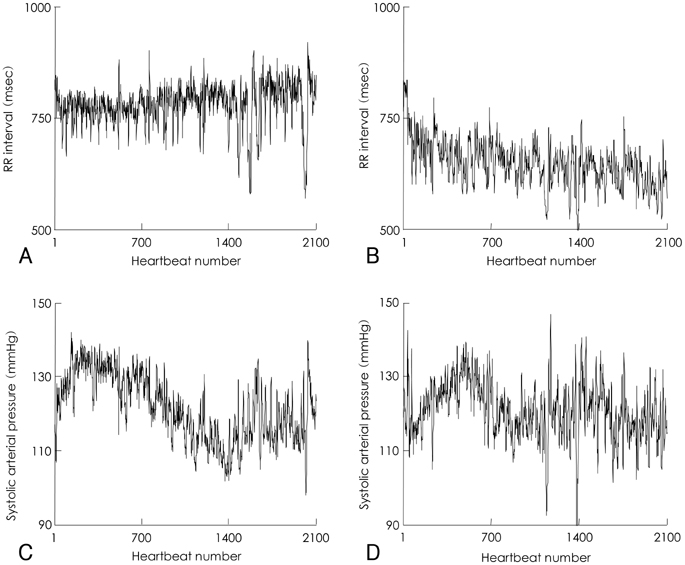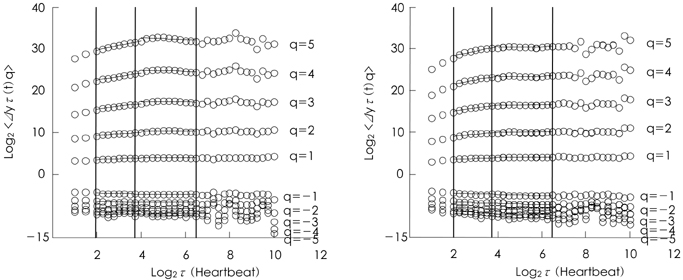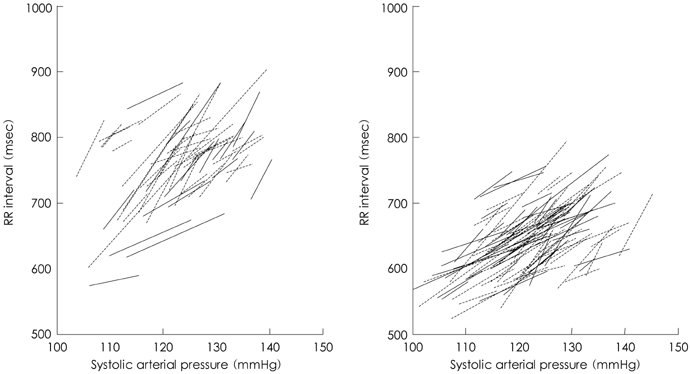Korean Circ J.
2007 Sep;37(9):443-448. 10.4070/kcj.2007.37.9.443.
Spontaneous Baroreflex Sensitivity and Multifractal Hurst Analysis of Heart Rate
- Affiliations
-
- 1Department of Pediatrics, College of Medicine, Hanyang University, Guri, Korea. mkyumm@hanyang.ac.kr
- 2Department of Cardiac and Vascular Center, Samsung Medical Center, Sungkyunkwan University School of Medicine, Seoul, Korea.
- KMID: 2093982
- DOI: http://doi.org/10.4070/kcj.2007.37.9.443
Abstract
-
BACKGROUND AND OBJECTIVES: This study was designed to examine whether the multifractal Hurst exponents of heart rate can estimate activating and deactivating spontaneous baroreflex sensitivity (SBRS).
SUBJECTS AND METHODS
Age and sex matched 24 healthy volunteers were placed in the supine position and head-up tilt position for 30 minutes, and the systolic blood pressure and heart rate were measured in an noninvasive manner. When the RR interval (RRI) sequence and systolic pressure sequence simultaneously increased or decreased for more than three successive beats, the slope of the linear regression line of systolic blood pressure and RR interval sequence was defined as the value of spontaneous baroreflex sensitivity (SBRS). From the RR intervals, very short-term (alpha range, < or =12 heartbeats), short-term (beta range, > or =12 heartbeats), and the multrifractal Hurst exponents were calculated to determine the linear correlation.coefficients for SBRS.
RESULTS
In the supine position, the linear correlation coefficients (p) of SBRS and H-5alpha, H-4alpha, H-3alpha, H-2alpha, H-1alpha, H1alpha, H2alpha, H3alpha, H4alpha, H5alpha were -0.195 (NS), -0.207 (NS), -0.232 (NS), -0.282 (NS), -0.355 (NS), -0.621 (0.003), -0.650 (0.001), -0.677 (0.001), -0.699 (0.0006) and -0.708 (0.0005), respectively. In the tilting position, the linear correlation coefficients of SBRS and H-5beta, H-4beta, H-3beta, H-2beta, H-1beta, H1beta, H2beta, H3beta, H4beta, H5beta were 0.024 (NS), 0.020 (NS), 0.010 (NS), -0.028 (NS), -0.193 (NS), -0.627 (0.0034), -0.607 (0.0045), -0.598 (0.0053), -0.572 (0.0084) and -0.539 (0.0141), respectively.
CONCLUSION
Some of the very short-term and short-term generalized Hurst exponents, such as H5alpha and H1beta, can be used for the estimation of spontaneous baroreflex sensitivity during patient placement in the supine and head-up tilt position, respectively.
Keyword
MeSH Terms
Figure
Reference
-
1. Jun JS, Jun SI, Cho KJ, et al. Assessment of autonomic nervous function in young adults by power spectral analysis of heart rate variability. J Korean Acad Rehabil Med. 1997. 21:928–935.2. Bristow JD, Honour AJ, Pickering GW, Sleight P, Smyth HS. Diminished baroreflex sensitivity in high blood pressure. Circulation. 1969. 39:48–54.3. Osculati G, Grassi G, Giannattasio C, et al. Early alterations of the baroreceptors control of heart rate in patients with acute myocardial infarction. Circulation. 1990. 81:939–948.4. Eckberg D, Drabinski M, Braunwald E. Defective cardiac parasympathetic control in patients with heart disease. N Engl J Med. 1971. 285:877–883.5. Parati G, Di Rienzo M, Mancia G. How to measure baroreflex sensitivity: from the cardiovascular laboratory to daily life. J Hypertens. 2000. 18:7–19.6. Dietrich A, Riese H, van Roon AM, et al. Spontaneous baroreflex sensitivity in preadolescents. J Hypertens. 2006. 24:345–352.7. Yum MK, Kim JH. A very short-term intermittency of fetal heart rates and developmental milestone. Pediatr Res. 2003. 53:915–919.8. Yum MK, Kim K, Kim JH, Park EY. A consistent abnormality in the average local smoothness of fetal heart rate in growth-restricted fetuses affected by severe pre-eclampsia. Hypertens Res. 2004. 27:911–918.9. Parati G, Mutti E, Frattola A, Di Rienzo M, Castiglioni P, Mancia G. Beta-adrenergic blocking treatment and 24-hour baroreflex sensitivity in essential hypertensive patients. Hypertension. 1994. 23:992–996.10. Bertinieri G, Di Rienzo M, Cavallazzi A, Ferrari AU, Pedotti A, Mancia G. Evaluation of baroreceptors reflex by blood pressure monitoring in unanesthetized cats. Am J Physiol. 1988. 254:H377–H383.11. Parati G, Di Rienzo M, Bertinieri G, et al. Evaluation of the baroreceptor-heart rate reflex by 24-hour intra-arterial blood pressure monitoring in humans. Hypertension. 1988. 12:214–222.12. Parati G, Frattola A, Di Rienzo M, Castiglioni P, Pedotti A, Mancia G. Effects of aging on 24 hour dynamic baroreceptor control of heart rate in ambulant subjects. Am J Physiol. 1995. 268:H1606–H1612.13. Parati G, Di Rienzo M, Bonsignore MR, et al. Autonomic cardiac regulation in obstructive sleep apnea syndrome: evidence from spontaneous baroreflex analysis during sleep. J Hypertens. 1997. 15:1621–1626.14. Parati G, Di Rienzo M, Castiglioni P, Villani A, Tortorici E, Mancia G. Spontaneous baroreflex sensitivity: from the cardiovascular laboratory to patient's bedside. Frontiers of Blood Pressure and Heart Rate Analysis. 1997. 219–240.15. Pincus SM, Cummins TR, Haddad GG. Heart rate control in normal and aborted-SIDS infants. Am J Physiol. 1993. 264:R638–R646.16. Pikkujamsa SM, Makikallio TH, Sourander LB, et al. Cardiac interbeat interval dynamics from childhood to senescence: comparison of conventional and new measures based on fractals and chaos theory. Circulation. 1999. 100:393–399.17. Yoon JH, Kang JH, Kim BJ, et al. Relationship between heart rate turbulence and heart rate variability in Korean adults with structurally normal heart. Korean Circ J. 2006. 36:126–132.18. Schwartz PJ, la Rovere MT, Vanoli E. Autonomic nervous system and sudden cardiac death: experimental basis and clinical observations for post-myocardial infarction risk stratification. Circulation. 1992. 85:Suppl 1. I77–I91.19. Watkins LL, Grossman P, Sherwood A. Noninvasive assessment of baroreflex control in borderline hypertension: comparison with the phenylephrine method. Hypertension. 1996. 28:238–243.20. Jalife J, Slenter VA, Salata JJ, Michaels DC. Dynamic vagal control of pacemaker activity in the mammalian sinoatrial node. Circ Res. 1983. 52:642–656.21. Chun HJ, Kim SS, Sung JD, Pack DM. Determinants of heart rate variability in general Korean population. Korean Circ J. 2001. 31:107–113.22. Kleiger RE, Miller JP, Bigger JT Jr, Moss AJ. Decreased heart rate variability and its association with increased mortality after acute myocardial infarction. Am J Cardiol. 1987. 59:256–262.23. Jung HO, Seung KB, Lim HY, et al. Assessment of autonomic nervous system by the analysis of heart rate variability in patients with variant angina. Korean Circ J. 1999. 29:590–595.24. Kim JK, Kim JS, Park JI, et al. Heart rate variability in stable angina patients without history of myocardial infarction. Korean Circ J. 2001. 31:484–491.25. Cevese A, Gulli G, Polati E, Gottin L, Grasso R. Baroreflex and oscillation of heart period at 0.1 Hz studied by a-blockade and cross-spectral analysis in healthy humans. J Physiol. 2001. 531:235–244.26. Yum MK, Oh AY, Lee HM, et al. Identification of patients with childhood Moyamoya diseases showing temporary hypertension after anesthesia by preoperative multifractal hurst analysis of heart rate variability. J Neurosurg Anesthesiol. 2006. 18:223–229.
- Full Text Links
- Actions
-
Cited
- CITED
-
- Close
- Share
- Similar articles
-
- Comparison of Graded and Bolus Infusion Methods in Baroreflex Measurements in Rabbits
- Influence of Anesthesia Induction with Ketamine on Baroreflex Control of Heart Rate
- The Influence of Sevoflurane Anesthesia on Various Kinds of Spontaneous Baroreflex Sensitivities
- Comparison of METHODS Assessing Spontaneous Baroreflex Sensitivity during Sevoflurane Anesthesia: Sequence versus Transfer Function Analysis
- The Effect of Low-dose Atropine on Baroreflex Sensitivity Assessed by Transfer Function Analysis





